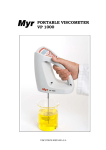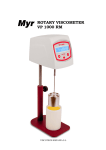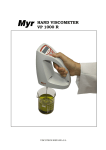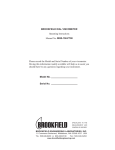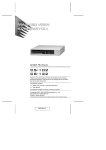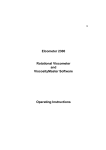Download Operating Instructions Rotation Viscometer PCE
Transcript
www.industrial-needs.com PCE Instruments UK Ltd Units 12/13 Southpoint Business Park Ensign Way, Southampton Hampshire United Kingdom, SO31 4RF Phone +44 ( 0 ) 2380 98703 0 Fax +44 ( 0 ) 2380 98703 9 e-mail: [email protected] Operating Instructions Rotation Viscometer PCE-RVI 3 Version 1.0 27.08.2014 OPERATING INSTRUCTIONS www.industrial-needs.com Table of contents 1 General Information................................................................................................... 3 1.1 Introduction ......................................................................................................................................... 3 1.2 Area of Application .............................................................................................................................. 3 1.3 Hazard Symbols .................................................................................................................................. 3 1.4 Safety Precautions .............................................................................................................................. 4 1.5 Certification, Warranty and Documentation ........................................................................................... 5 2 Technical Data .......................................................................................................... 6 3 Putting Viscometer into Operation ............................................................................. 7 4 5 3.1 Unpacking the Viscometer ................................................................................................................... 7 3.2 Delivery Content .................................................................................................................................. 7 3.3 Battery Replacement ........................................................................................................................... 8 3.4 Inserting the Spindle ............................................................................................................................ 8 3.5 Installing the Spindle Guard ................................................................................................................. 9 3.6 Stand Construction (optional) ..............................................................................................................10 Operation ................................................................................................................ 12 4.1 Switch on and Configuration ...............................................................................................................12 4.2 Measuring ..........................................................................................................................................14 Calibration of the Equipment ................................................................................... 16 5.1 Viscometer Function Check ................................................................................................................16 5.2 Viscometers Automatic “Zeroing” ........................................................................................................16 6 Optional accessories ............................................................................................... 17 7 About the Viscosity .................................................................................................. 18 7.1 Description .........................................................................................................................................18 7.2 Further information about Fluids..........................................................................................................18 8 Viscosity Table ........................................................................................................ 20 9 Problem Solution ..................................................................................................... 20 2 OPERATING INSTRUCTIONS www.industrial-needs.com 1 General Information 1.1 Introduction The PCE-RVI 3 is a portable viscometer used to determine the viscosity of liquids. The ergonomical design of the viscometer (can also be used in combination with a sturdy optionally available stand), allows it to be used as either a mobile device or as a part of a permanent laboratory installation. The PCE-RVI 3 is battery powered and operates at a constant speed (20, 30, 50 or 60 rpm). The low energy consumption of the device enables it to be used non-stop for more than 24 hours without the need to replace the batteries. When ordering the device, the desired speed (rpm) must be stipulated, this is dependent upon the measuring range in which the viscometer is to be used. The viscosity values will be displayed in Milli-Pascal-Seconds (mPas). In order to cover the whole range of potential readings, the viscometer is supplied with a spindle set (R2R7, or optionally R1). An outstanding feature of the PCE-RVI 3 is its user friendliness, enabling it to be used during the production process, in laboratories or research facilities, providing fast and reliable viscosity values. 1.2 Area of Application The Viscometer PCE-RVI 3 has been developed in order to determine the viscosity of a variety of liquids. The device should only be used by appropriately trained and qualified personnel. When using the Viscometer the normal laboratory precaution and safety measures should be observed at all times. The Viscometer must not be used for any purposes other than those stipulated in the operating instructions. If the advice above is not adhered to, any statutory guarantee is declared null and void. 1.3 Hazard Symbols The commissioning and operation of the PCE-RVI 3 is quite straight forward providing that the instructions within the operating instructions are adhered to at all times. It can be hazardous to use the device for any purposes other than those for which the equipment was intended. For this reason, certain points within this operating instruction are highlighted as potentially hazardous, and must be carefully observed to prevent equipment damage or personal injury. Hazard This symbol in conjunction with the appropriate advice, warns the user of any potential danger or hazard. If due care is not observed, this could result in damage to the equipment or personal injury. Caution This symbol combined with the appropriate advice warns of the danger of potential equipment damage, should the advice not be heeded. 3 OPERATING INSTRUCTIONS www.industrial-needs.com Information This symbol warns of specific details relating to the viscometer which must be heeded all times. Users must pay close attention to the advice in this operating instruction, and be aware of and take into account all safety and hygiene standards concerning the local working conditions. Before operating the equipment, each user of the device should have read and fully understood the operating instructions. 1.4 Safety Precautions Operator safety cannot be guaranteed should the following advice not be heeded. Battery Operation The Viscometer is battery powered. The casing of the viscometer must never be removed when the device is in operation. The exchange or replacement of parts or components or the changing of settings of the viscometer must only be carried out by trained and qualified personnel. Only original manufacturer’s parts must be used. Before changing the batteries, the device must be turned off and the spindle removed. Explosive Environment Hazard The device must be used in areas where there is a danger of explosion or within the proximity of inflammable gases, or where there could be a potential build up of explosive gases. Malfunction Risk In order to avoid any potential damage, the equipment should not be used within strong electro-magnetic fields. For instance transmitters such as cell phones should not be used within close proximity of the viscometer. Should an error occur despite these precautions, then the device should be powered off and the supplier should be contacted. 4 OPERATING INSTRUCTIONS www.industrial-needs.com 1.5 Certification, Warranty and Documentation Certification The Viscometer PCE-RVI 3 has been thoroughly tested and inspected prior to dispatch. The output readings have been checked and fully correspond with the appropriate data input. The device conforms to statutory international safety standards. Warranty The Viscometer PCE-RVI 3 has a two year warranty against defects in materials or workmanship. During this period, any defective parts will be repaired or replaced free of charge. Warranty claims other than those previously mentioned are expressly excluded. Improper modifications, or repairs carried out by unauthorized third parties will result in the warranty being declared invalid. Inappropriate use of the device or neglecting to observe the safety precautions in the operating instructions will also lead to the invalidation of the warranty. At the end of the warranty period, it is advisable to arrange for a service contract to be taken out, so as to guarantee continued trouble free use of the device. For further information, please contact your supplier. Documentation An operating instruction is applied with each device. Extra copies of the operating instruction may be obtained from your supplier, please quote the serial number of the device and the manual which is required. We endeavor to review and edit this manual and assume no liability for printing errors or omissions. 5 OPERATING INSTRUCTIONS www.industrial-needs.com 2 Technical Data Power requirement Battery capacity Battery life Read out value Compatibility Spindles Speed Viscosity ranges (with standard spindles) Accuracy Repeatability Mass Weight Operating conditions Degree of pollution Protection class Portable Viscometer PCE-RVI 3 Alkaline batteries: 4 x AA/LR6 Rechargeable batteries: 4 x AA/R6 Alkaline batteries: 1900 mAh Rechargeable batteries: 2500 mAh 24 – 30 Std. continuous operation Fixed speed Spindle selection (R2-R7). Optional: R1 Dynamic viscosity (mPas) Fraction of the maximum measuring value Maximum measuring range Battery level 100 % compatible with the Brookfield method Standard spindle Set (R2 – R7) optional: R1 20 rpm 60 rpm (only one speed preset) Type VP20: 200 – 200000 mPas Type VP60: 66 – 66600 mPas ± 2% of the read out value ± 1% 10,5 x 16 x 25,5 cm 1150g Between +10°C and +40°C (at max. relative humidity of 80% without condensation) Applicable up to a height of 2000m over NN Only suitable for using inside buildings 2 Ip 20 6 OPERATING INSTRUCTIONS www.industrial-needs.com 3 Putting Viscometer into Operation 3.1 Unpacking the Viscometer After receiving the Viscometer, proceed as follows: 3.2 Check the Viscometer packaging for possible transport damages If the packaging is damaged, contact the responsible transport before opening the packaging. After the equipment has been unpacked, check for any visible signs of damage and if any is found contact your supplier. Remove all the packaging items and transport safety, recyclable material should be disposed in the intended containers, the main reason. Delivery Content 7 Portable rotation viscometer PCE-RVI 3 Standard spindle set (R2-R7) Spindle guard Tools 4 x additional alkaline battery AA / LR6 (6V) OPERATING INSTRUCTIONS www.industrial-needs.com 3.3 Battery Replacement The portable Viscometer PCE RVI 3 is battery powered and is delivered with 4 pre-installed alkaline batteries (4x AA/LR6 (6V) plus 4 extra replacement batteries). The Viscometer can be operated with alkaline batteries (Type AA/LR6) or rechargeable batteries (Type AA/R6). In constant use, the battery life is 24-30 hours. There is a battery charge indicator on the display. The batteries are located on the underside of the Viscometer. They should be replaced as follows: 3.4 Remove the fastening screw as shown. Remove the cover of the battery compartment and exchange the batteries. (Making sure to observe the correct polarity) To re-install the battery cover, slide the tabs into the slots and secure with screw. The serial number and technical data of the Viscometer are found on the battery compartment cover. Inserting the Spindle Apart from the spindle R7, all the spindles are disc spindles. For this reasons, the spindles must be dipped slowly into the liquid being tested, to avoid any build up of air bubbles under the disc. Hold the shaft firmly in one hand and push the spindle from underneath onto the rotation axis. To screw the spindle onto the shaft, turn the spindle anticlockwise, as shown on the illustration. After attaching the spindle to the shaft, dip the spindle into the liquid up to the upper marker point. Take care not to come into contact with the sides of the container with either the spindle or the shaft as this could result in the vertical alignment of the shaft being knocked out of position or damaged. 8 OPERATING INSTRUCTIONS www.industrial-needs.com Care must be taken at this point, in order to avoid bending the spindle or damaging the shaft. Both the thread on the spindle and on the shaft must be absolutely clean and dirt free. The R7 spindle must be dipped into the liquid up to the middle marker point. The spindle is made of stainless steel. Each spindle is separately coded on the head of the spindle. 3.5 Installing the Spindle Guard In order to protect the most delicate working parts of the PCE RVI 3, (The spindle and the shaft) from being damaged, a cylindrical spindle guard is supplied. This feature allows the volume of the sample to be tested to be limited to the capacity of the cylinder. Readings are therefore more accurate, and as the cylinder fits exactly into an 800mm beaker enables samples to be tested without the need to physically hold the device. The assembly of this apparatus is quite simple, providing the illustrated instructions are referred to and adhered to. Screw the spacer bars (1) clockwise into the pre-drilled holes in the Cylindrical Guard (2). Then place the upper plate (3) on top of the spacer bars and use the supplied screws to fix. 9 OPERATING INSTRUCTIONS www.industrial-needs.com After assembling the spindle guard, it must be attached to the Viscometer. Carefully push the Viscometer shaft into the upper disc of the spindle guard assembly as shown in the diagram. Using the Allen key provided, carefully tighten the spindle assembly to the Viscometer shaft. Take extra care when tightening the fixing screws on the spindle guard to the Viscometer, so as to avoid damage to the shaft or spindle. After the spindle guard has been installed, the Viscometer is stable enough to stand upright, without the need to physically hold on to it. 3.6 Now attach the desired spindle to the shaft, as described above. The device is now ready for use. Stand Construction (optional) Proceed as follows: Push the rod into the bottom of the stand holder. Turn the star-shaped grip to secure the rod. Push the Viscometer holder onto the rod. Adjust the height of the holder and tighten it using the twist-grip. After setting up the stand, secure the Viscometer in the holder as shown in the picture. To avoid damage to the spindle and shaft, pay attention when securing the Viscometer to the holder. 10 OPERATING INSTRUCTIONS www.industrial-needs.com Carefully push the viscometer into the opening. When the shaft is in the holder, carefully press the viscometer downwards to lock it into the holder. Attach the viscometer with the included Allen screw to the holder. Attach the required spindle to the shaft of the viscometer. The viscometer is now applicable The appliance can only be used on a flat surface, as the stand is not equipped with the height-adjustable feet. 11 OPERATING INSTRUCTIONS www.industrial-needs.com 4 Operation 4.1 Switch on and Configuration The PCE-RVI 3 configuration is extremely simple, because the only parameter that can be adjusted is the one that determines the spindle. To adjust the display read out use the ENTER-button and “ ” and “ ” buttons. Switch the Viscometer on by pressing the “ENTER”-button for 6 to 10 seconds. The following read out appears on the display with the battery symbol. Then the main read out with the last saved settings appears on the display. The following information is shown on the display: speed (rpm), measuring unit (mPas), spindle type (R1R7) and the measuring range. As previously mentioned, the Viscometer functions with a speed (20, 30, 50 or 60 rpm) that is selected during the ordering process and a measuring unit: milli Pascal seconds (mPas). The only adjustable parameter is the selection of the spindles. If measurements are to be carried out using a different spindle to the one that is shown on the display, then adjust the parameter, proceed as follows: Press the “ The last spindle selected flashes on the screen. The measuring range appears on the right, which is calculated out of the spindle and the speed. ” or“ ” button. The following information appears on the display: 12 OPERATING INSTRUCTIONS www.industrial-needs.com The measuring range is dependent upon the maximum measurable viscosity value for the spindle/speed combination being used. By providing this value, it is much simpler to choose the correct spindle for the testing of a particular fluid. Use the ^or > keys to select the correct spindle between R1 and R7. When you have chosen the correct spindle size, press “ENTER” to confirm your selection. If you do not press “ENTER” within 15 seconds after selecting a spindle, then the Viscometer automatically returns to the main menu, and saves the information of the last spindle which has been used. Therefore it is very important to check that the selected spindle corresponds to the spindle shown on the display screen. 13 OPERATING INSTRUCTIONS www.industrial-needs.com 4.2 Measuring Start measurement Press the “ENTER” button to make the spindles rotate and to begin the measurements. The spindle starts to rotate; the display shows the following values: Speed (20, 30, 50 or 60 rpm), spindle selection as well as question marks which show that the viscometer is determining the viscosity values. Determining Measuring Values The viscosity value (in mPas) and the fraction of the maximum measurable viscosity value appear. If the operating instruction is not adhered to and the viscometer is used without spindle protection, make sure that the spindle is stood upright in the centre of the sample container before turning on the equipment. During the measuring process, in particular when measuring without a stand, make sure to stand the viscometer upright in the centre of the sample container, to prevent incorrect measurements. Measuring Range Limit If the following read out appears on the display, then the upper measuring range limit has been exceeded. In this case the spindle must be swapped. It is recommended that the viscometer is operated in the measuring range between 10% and 90% of the full scale .However measuring values between 5% and 100% of the full scale are also shown. If the measuring value is below 5% then the viscometer shows a measuring value of “0”. 14 OPERATING INSTRUCTIONS www.industrial-needs.com Finish Measurement To finish the measurement, press the “ENTER” button again. The current measuring value and the fraction of the full scale remain on the display. To start a new measurement, proceed as described above. Switch off Viscometer Press the “ENTER” button for a couple of seconds. The following read out appears on the display: Do not forget to switch off the equipment after the measurement (press the “ENTER” button down for a while). Otherwise the Viscometer will stay active and the batteries will self-discharge. In case the battery level is too low then the Viscometer automatically switches off and the following read out appears on the display: 15 OPERATING INSTRUCTIONS www.industrial-needs.com 5 Calibration of the Equipment Before the delivery the Viscometer is calibrated with Newtonian oils. We recommend a regular recalibration, depending on how often the equipment is used. Please contact your supplier for an appropriate calibration. 5.1 Viscometer Function Check We recommend a functions check with our viscosity-standard fluids, which are available on request. The calibration liquids are calibrated at two various temperatures (20°C and 25°C) to create a better connection between temperature and viscosity. Depending on the type, the following liquids are available: Viscometer Type VP 20 VP 60 Viscosity Standard (mPas) Approx. 5000 Approx. 2500 We recommend the usage of the spindle R4, whilst the function check is being carried out. After switching on the Viscometer and at least 5 measuring values, the measuring values correspond to the value (including tolerance) on the certificate of standard fluids. The viscosity is extremely temperature-dependent, so we recommend the viscometer should only be used within the temperature ranges stipulated in the guidelines for the certification of standard fluids. 5.2 Viscometers Automatic “Zeroing” If the viscometer isn’t dipped into a liquid, but it starts rotating and the value “0” isn’t displayed, then proceed as follows: Turn the Viscometer on by pressing the “ENTER”-button. The start read out appears with a battery symbol. Press the “▼“ button and then press the “ENTER” button to get to the “zeroing function” The following read out appears on the display: Press the “ENTER” button, the following read out appears on the display 16 OPERATING INSTRUCTIONS www.industrial-needs.com Do not forget to remove the spindles during the automatic “zeroing” It is also recommended that the “zeroing” is carried out on the stand and not whilst holding in the hand. If this is not possible, then the viscometers vertical alignment should be ensured. 6 Press the “ENTER” button, to begin with the “zeroing”. During this process the following read out appears on the display: After the “zeroing” has been successfully executed, the display automatically returns to the measuring mode. Optional accessories Battery charger R6 AA/Ni-Cd/Ni-Mh Rechargeable batteries Stand Special stand R1 Spindle holder Certified Newtonian calibration oils (600 ml) 17 OPERATING INSTRUCTIONS www.industrial-needs.com 7 About the Viscosity 7.1 Description The PCE RVI 3 is a portable rotational viscometer, used to measure the viscosity of many types of liquid. The measurements are taken in accordance with the Brookfield method. The readings obtained from the PCE-RVI 3 are perfect for comparing results taken using other types of Brookfield Viscometers. The operating principle of the PCE RVI 3 viscometer is the same as with all rotational viscometers. A spindle, disc or cylinder is dipped into the fluid being analysed, the torque required to set the spindle into motion is then measured. This torque reading is based on a combination of the spindle speed and the geometry of the spindle being used. Using this method the viscosity value is displayed in mPas. The viscosity value is dependent upon the resistance exerted by the liquid against the spindle, and is also directly proportional to the spindle speed and the geometry of the spindle. The Viscometer has been calibrated to give viscosity readings in mPas. Using a combination of various spindle types with the differing viscometer models (VP 20 and VP 60), enables readings to be taken across the entire measurement range. 7.2 Further information about Fluids Viscosity Viscosity is the characteristics property of a liquid. It is the measurement of the internal resistance within a liquid when individual layers within the liquid are brought into motion against each other. Viscosity values are also highly influenced by temperature. The standard measurement units for dynamic viscosity are: mPas (S.I) or cP (C.G.S) 1 mPas = 1 cP (centi-Poise) 1 dPas = 1P (Poise) 1 dPas = 100 mPas Laminar Flow Occurs when a fluid flows in parallel layers with no disruption between the layers. Laminar flow is fundamental to the determination of dynamic viscosity. Turbulent Flow When a certain flow rate is exceeded, disruption between the layers of liquid can occur. This results in an apparent increase in shear stress and results in falsely high viscosity readings. The change from Laminar to Turbulent flow can be recognized by a marked increase in viscosity values at a particular speed. Generally liquids can be classified by their shear stress/ shear rate ratios. Newtonian Fluids In Newtonian fluids the shear strain rate and the shear stress are both directly proportional to each other. At a constant temperature the viscosity of a Newtonian fluid remains constant regardless of the viscometer, spindle or rotation speed. Examples of fluids with these properties are water or low viscosity engine oil. Non-Newtonian Liquids In these liquids there is no linear relationship between shear strain rate and the shear stress. Therefore differing viscosity values will be obtained under different environmental and operating conditions. The apparent viscosity of the liquid must be established by a fluid analysis. This result cannot be reproduced by using a different viscometer, unless environmental and operating conditions are identical, and the analysis is carried out using the same method of data collection. 18 OPERATING INSTRUCTIONS www.industrial-needs.com The following variables can influence viscosity measurements: Viscometer type Dimensions of sample container Fill level Sample temperature Spindle Rotation speed Whether or not the spindle protector is being used. Duration of the test Invariably any change in working methods will lead to a change in results. Non-Newtonian liquids have a variety of properties: Pseudoplastic A fluid whose viscosity decreases with an increase in shear rate. Well known pseudoplastic fluids are: oil, paint, milk, ink or jam. Plastic Under static conditions, these fluids appear to be solid. In order to carry out an analysis on these fluids, it is necessary for them to be in their liquid form, when they will display characteristics similar to pseudoplastic or dilatant fluids. Examples: toothpaste, chocolate or fat Dilatant A fluid whose viscosity increases with an increase in shear rate. Example: Solution of sugar and water. Mixture of sand and water. Time-dependent Liquids A fluid whose viscosity will change not only due to the shear rate, but also as a result of the time lapse since the shear process was started. Thixotropic Liquid A time dependent fluid. The viscosity reduces when the fluid is stirred, after which the viscosity begins to increase over time. Examples: Ketchup, honey, non-drip paint, mayonnaise Rheopexy Liquids A time dependent fluid. The viscosity increases when the fluid is stirred, after which the viscosity begins to reduce over time. Various reference liquids viscosity values Substance Motor Oil SAE 10 Olive Oil Varnish (Airbrush) Yoghurt Sugar Solution 70% Lube Oil Concentrated Juice Printing Ink Honey Nano Cellulose Toothpaste Viscosity (mPas) 65 84 100 150 400 50 – 1000 1500 550 – 2200 10000 8000 – 10000 100000 19 OPERATING INSTRUCTIONS www.industrial-needs.com 8 Viscosity Table Spindle Model VP20 VP60 R1 R2 R3 500 166 2000 660 5000 1600 R4 R5 Viscosity in mPas 10000 20000 3300 6600 R6 R7 50000 16600 200000 66600 Viscosity measuring range (with standard spindles) (Between 10% - 100% of the maximum measuring value): Type VP20: 200 – 200000 mPas Type VP60: 66 – 66600 mPas 9 Problem Solution Problem Viscometer is not functioning Solution Check the battery level The equipment does not display “0” in Carry out an automatic “Zeroing The rotation is not stable and not accurate Always ensure that the Viscometer is standing upright Always ensure that the rotational movements of the spindle are equal Ensure that the correct temperature of the fluid being tested is maintained Check the characteristics of the fluids to be tested, and then adjust the test parameters accordingly. 20























